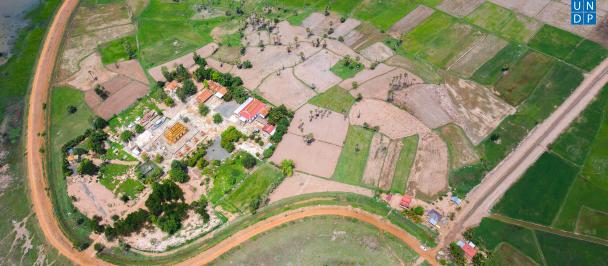Facilitating the standard operating procedures of early warning systems was integrated into the second consultative meeting for the development of a National DRR plan 2019-2023. Photo credit: MOWRAM Cambodia
Siem Riep, May 10 2019. Frameworks which prevent, not react, to disasters and establishing effective early warning systems have been the focus of a national workshop held in Siem Reap this week.
With support from United Nations Development Programme (UNDP) and the Royal Government of Cambodia’s National Committee for Disaster Management, May 2019 marked the second consultative workshop for developing a new 5-year Strategic National Action Plan for Disaster Risk Reduction (SNAP-DRR 2019-2023). Held in Siem Reap May 7 – 9, the workshop was attended by 78 participants from 22 ministries including key members of the National Committee for Disaster Management and Provincial Committees for Disaster Management across 18 provinces, as well as representatives from UNDP.
The workshop followed a first consultation meeting, held last month in Phnom Penh. The initial workshop defined the outcomes of the previous NAP-DRR 2014-2018 as well as identifying potential priorities for its successor. The importance of such plans is highlighted as a key component of the Royal Government of Cambodia’s Rectangular Strategy IV, and comes at a critical time for the nation. “According to the World Disaster Risk Index of 2016, Cambodia is ranked as the 9th most vulnerable country in the world. Continuing global adaptation changes and increases in Cambodia's risk of disasters makes it difficult for Cambodia to cope with and address these issues on its own, due to a lack of resources and limited capacity of response,” stated His Excellency Yin Khunphoy Secretary General and Director of NCDM in his opening remarks.
The second workshop was enacted with dual purpose. First, it presented opportunity for consultation on the 2019 – 2023 SNAP-DRR; second, it enabled validation of standard operative procedures for multi-hazard early warning systems (EWS) in Cambodia. Early warning systems are currently the focus on the UNDP-supported ‘Strengthening Climate Information and Early Warning Systems in Cambodia’ project, enabled by funding from Least Developed Countries Fund under the Global Environment Facility. Previous versions of Cambodia’s early warning systems plan focused solely on flooding – the new, multi-hazard approach will more accurately reflect the diverse nature of disasters within Cambodia. The objective of early warning systems plans is to provide sufficient climate information that can be accessible and utilized by decision makers to reduce associated risks.
The workshop enabled participants to work in relevant clusters and, using the Sendai Framework for Disaster Risk Reduction and Sustainable Development Goals as guidelines, develop priorities, activities and expected budgets for standard operating procedures of the upcoming SNAP-DRR and EWS plans. Complementing global frameworks is an important part of ensuring that such DRR plans are conducive to ongoing development, as stated by UNDP Bangkok Senior Advisor for Disaster Risk Reduction, Mr. Sanny Ramos Jegillos: “Strategic frameworks should recognise that building resilience nowadays is very complex. Disasters will not just impact on agriculture, but also on other livelihoods. Thanks to the government of Cambodia, economic growth has been unprecedented - but that economic growth can be threatened. Development is not sustainable if disaster is not addressed”.
Participants found the workshop to be not only a good opportunity to input into future national plans but also understand the role of disaster risk reduction within their own ministry and collaborate with peers from across the country. “The workshop is useful as it provides opportunities for people from different ministries to work with the National Committee for Disaster Management and Provincial Committees for Disaster Management to develop a plan together…we want to see a cohesive response when disaster strikes. This workshop gives us opportunity to share experiences and learn about challenges and gaps. Because we are all together, we can then work together on how to address those gaps,” said a representative of the Ministry of Health.
It is hoped that the NAP-DRR will officially be released in October 2019; whereas the standard operating procedures for early warning in Cambodia would be developed within this year.
For more information, contact Mr. Muhibuddin Usamah, Disaster Management Specialist, Project Manager, Strengthening Climate Information and Early Warning System in Cambodia, muhibuddin.usamah@undp.org
About UNDP Cambodia and Disaster Risk Reduction: In line with the Rectangular Strategy and UNDP ‘Signature Solutions’ on building resilience and sustainable planet, UNDP will support environmental protection, working with the Government to ensure sustainable natural resource management and build climate resilience. This pillar is closely associated with the peace, participation and accountability theme, which addresses governance issues to improve environment and natural resource management.

 Locations
Locations




